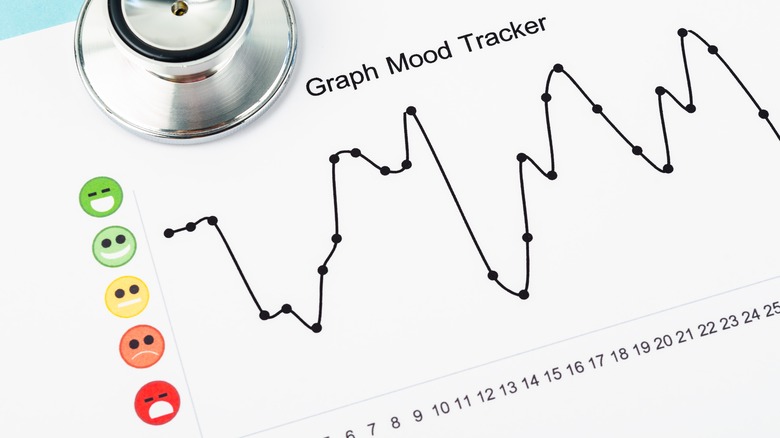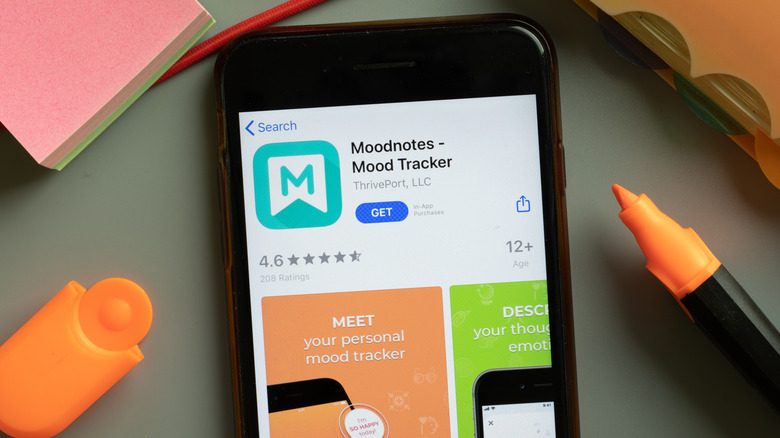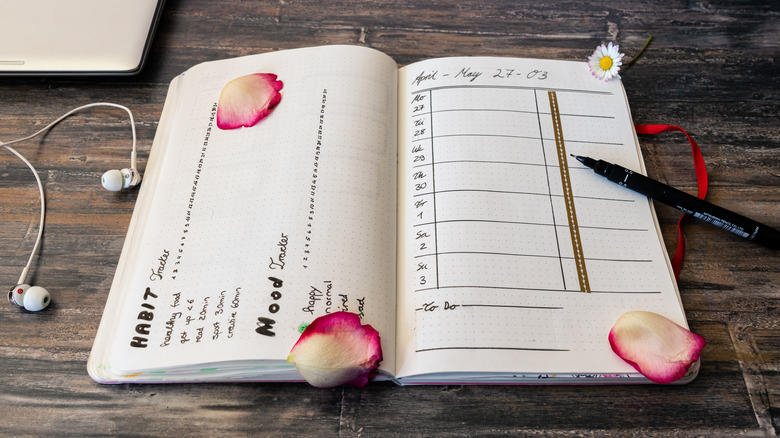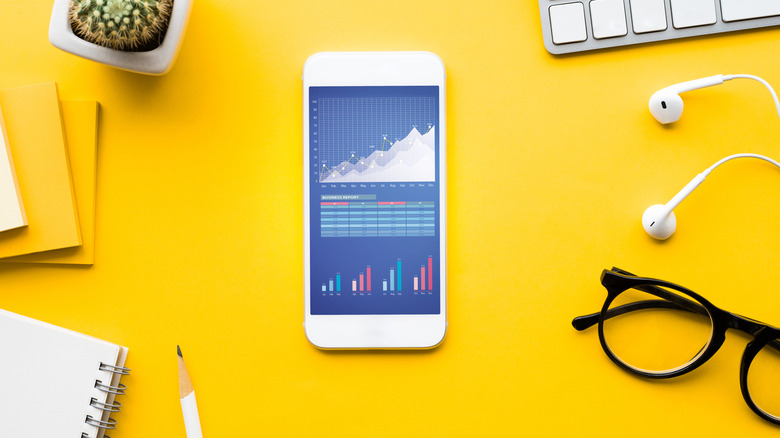How To Use Mood Tracking To Get A Better Sense Of Your Triggers
Throughout each day, our moods change based on what's happening around us, what we're thinking, and what we're feeling. In an article for GoodTherapy, social worker Jenise Harmon explained that some people have inherently stable temperaments. Unless they're dealing with difficult circumstances, their moods don't shift much throughout the day or over time. Other people have more sensitive temperaments, and their moods fluctuate frequently as they deal with their daily circumstances, thoughts, and emotions. People living with mood disorders or mental health conditions may experience severe mood swings that happen quickly, with seemingly little provocation.
Unless you're having mood swings or going through a major mood shift, you probably don't notice how often your moods change or particular circumstances that cause your mood to change. That's where mood tracking comes in! Mood tracking involves logging your moods throughout the day, each day, for a designated period of time. Having a log of your moods over time gives you invaluable insight into your overall mental health and what triggers changes in your mood.
Not sure if mood tracking is for you or how to get started? We've got you covered.
Mood tracking for overall mental health
Everyone can benefit from tracking their moods, even if they're not dealing with mental health issues. Most of us are so busy with the external circumstances of our lives that we don't take much time to connect with what we're thinking and feeling throughout the day. Because of this, changes to your mood can come seemingly out of nowhere.
Like when you're slammed at work, rushing to get coffee 15 minutes before your next appointment, and when you get to Starbucks, you find out they didn't get your mobile order. In a moment, all your composure is gone. Maybe you're burning with anger that borders on rage, or you suddenly burst into tears. These monumental mood shifts aren't proportionate to the event because they're not really about your mobile order not going through. If you're not taking the time to pay attention to your thoughts and feelings throughout the day, you'll be blindsided when that one last thing breaks you down.
Mood tracking allows you to see how you're feeling over time and identify when the emotional pressure is building. This gives you the information you need to prepare for or prevent these big mood swings. It also allows you to vent your feelings before they build up and explode at a to-go counter.
Mood tracking for anxiety and depression
Tracking your moods over time is particularly effective for people who deal with anxiety and depression. Recording your mood daily, or even multiple times a day, for an extended period of time, is crucial in identifying the difference between a few bad days and a depressive episode because you can see exactly how long you've been feeling down.
One study published in the medical journal "Behaviour Research and Therapy" found that mood tracking can also help predict depressive episodes. The study asked people diagnosed with anxiety and depression to track their moods and journal about their feelings every day for 21 days. When the researchers examined the data, they found that anxiety was a strong predictor of a depressive episode.
A review of research into the use of mental health apps published in the "Journal of Affective Disorders" found that people who regularly tracked their feelings and anxiety symptoms with their smartphones experienced a significant decrease in anxiety symptoms over time. The authors of the study posited that this was because tracking their moods on their phones offered an immediate intervention during episodes of anxiety.
So, if you're dealing with depression and/or anxiety, tracking your moods is an effective way to get insight into and manage your symptoms.
Mood tracking for mood and personality disorders
Severe mood swings and trouble regulating emotions are characteristic of both bipolar disorder (BD) and borderline personality disorder (BPD). Research published in the "Journal of Affective Disorders" has shown that mood tracking is an essential part of treatment for people living with these mental health conditions because it helps them identify the circumstances, thoughts, and feelings that lead to mood shifts.
Treatment for BPD often involves a specific kind of therapy called dialectical behavior therapy (DBT), per a study published in the "Journal of Medical Internet Research Mental Health." A big part of this treatment is using a "DBT diary," which is essentially a very structured mood tracker, to record thoughts, feelings, and overall mood on a daily basis. This information is shared with the DBT therapist. Extensive research has proven that mood tracking in this way is very effective for managing BPD because it allows the person living with BPD to identify and avoid triggers and change their behaviors when triggered.
A study published in the "International Journal of Bipolar Disorders" found that people living with BD found similar benefits from mood tracking. BD involves cycling between manic and depressive episodes, so tracking moods over time allows people living with BD to identify when they're headed into a manic or depressive episode. It can also help them identify what triggers these episodes and help them change their behaviors around their triggers.
Mood tracking helps identify patterns
Now that we know that regular mood tracking can benefit everyone who wants more insight into their mental health, whether or not they're dealing with mental health issues, it's time to dig into why this tool is so effective.
The power of mood tracking is that it gives you a record of your moods over time. You can look back at all the emotional data you've collected and see the whole picture in a concrete way instead of relying on vague assessments based on your current feelings like, "I feel like I've been in this rut for ages!"
Reviewing your emotional data will also help you notice patterns. People assigned female at birth may notice that their mood changes around the same time every month and connect that to their menstrual cycle. You may notice that your mood consistently dips on a certain day of the week or at a certain time of day. Or you might realize that your mood plunges whenever you have a certain kind of appointment or when you see a certain person.
Once you've noticed these patterns in your moods, you can investigate what's behind them to get a better understanding of your triggers.
Using mood tracking patterns to identify triggers
The patterns you find in your emotional data happen for a reason. Those reasons are your emotional triggers. Triggers are anything that causes an extreme emotional reaction by activating our innate "fight or flight" response. When this response is activated, our emotional reactions become intense because of the perceived threat. This has a major impact on our mood and our actions.
Though triggers are most often associated with traumatic experiences. Psychologist Mariana Plata explains in Psychology Today that we all have emotional triggers that bring up an emotional reaction that's stronger than usual, but not as intense as triggers associated with trauma. Plata defines emotional triggers as anything that makes you really uncomfortable and causes a difficult emotional reaction.
Once you identify patterns in your moods over time — like feeling down every time you see a certain person — you can explore what emotional trigger is behind that pattern. Maybe you're not processing an interaction you had with that person. Or maybe something's happening in their life that reminds you of a difficult situation in your life.
Once you understand your emotional triggers, you can start the hard work of addressing them, which will improve your overall mental health.
How to track your moods
If you're thoroughly convinced that tracking your moods is a great way to improve your mental health, you're probably wondering how to get started. Mood tracking is easier than you think because there are so many ways to do it, and you can choose the method that works the best for your life.
Most of us are basically attached to our smartphones, so a mood-tracking app is often the most convenient option. The Apple App Store and Google Play Store have dozens of apps, free and paid, that makes tracking your mood as easy as opening an app, choosing an icon, and typing in a few words.
If you're more old school, you can start a journal dedicated to mood tracking. You can use any old journal or buy one specifically designed for mood tracking with set journal prompts. You can also download a Mood Chart to fill out daily. Just Google "mood charts" and you'll find several research-backed styles. Pick the one you like, and fill it out on your computer or print it off and take the time to write it all out.
And if you want something truly simple, you can just jot down your feelings in your Notes app or a Google doc.
Mood tracking with an app
A great mood-tracking app will allow you to record your overall mood and specific emotions, and give you a place to add your own notes about your feelings or what's happening at the moment.
Many mood-tracking apps have additional functionality aimed at building coping skills. For example, CBT Thought Diary prompts you to record your mood and your specific feelings, and then offers guided journal prompts to help you work through difficult feelings based on the principles of Cognitive Behavioral Therapy. DailyBean allows you to track your moods alongside your habits and daily activities so you can start to see how each thing you're doing impacts your moods.
Research has shown that apps are not only convenient but effective for mood tracking. One study published in the "Journal of Medical Internet Research Mental Health" found that people who used mood-tracking apps gained more insight into their mental health and behavior, which helped them feel better. Another study found that mood tracking with an app helped teens with mental health issues mitigate their negative moods because the app was an accessible way to analyze their feelings as they happened (via Frontiers in Psychology).
So, if you're looking for a way to easily record your moods and access the data, an app could be the answer.
Other ways to track your mood on your phone
Apps specifically made for mood tracking aren't the only way to track your moods on your phone, though. Pretty much every smartphone comes with a pre-installed note-taking app, and this app can be a great way to record how you're feeling. Like a blank paper journal, your phone's pre-installed note-taking app gives you a blank page so you can get everything out any way you'd like. Just add the date, what you're feeling, then write whatever feels helpful at the time.
If all that typing is too much for your thumbs, you can try using the pre-installed voice recording app on your phone. Keeping an audio mood journal can be quicker and more accessible than typing or writing out your feelings. Some people also find they can be more candid about their feelings when they're speaking rather than writing, so an audio mood journal might be more honest and revealing.
If you're tracking your mood to notice patterns or find your triggers, these methods will be a bit more work intensive, because you have to go back and read through or listen to everything you've recorded.
Mood tracking with a journal
If you're one of those people who loves the process of writing their feelings on paper, there are a bunch of different ways to track your moods by journaling. To get started, decide whether you want to use a blank journal or one that's specifically designed for mood tracking.
Any blank journal can be a mood tracker if that's what you use it for. Just add the date and time, then write down what you're feeling. If you want, you can also journal for a bit about what's going on. This will help with identifying triggers and patterns. If you need something a little more organized, you can purchase or make a mood-tracking journal. Some have mood charts for each day, while others have prompts to help you write about your feelings and experiences.
If you're a bullet journal enthusiast, therapist Lindsay Braman has some awesome recommendations. As an artist, Braman loves the idea of making mood tracking into a creative art project, but she always suggests using a template to ensure you're including all the information you need to make mood tracking effective.
The best way to track your moods with a journal is to carry it with you so you can journal throughout the day as your mood changes. However, you can also set aside time to reflect on the day and update your journal.
Mood tracking on your computer
Many of us are almost as attached to our laptops as we are to our smartphones, especially during the workday. If that's you, then you might want to try mood tracking on your computer.
In a blog for Depression Warrior, veteran mental health writer Laura Becker shares that there are several convenient options for tracking your moods from a laptop or desktop. She uses a website called Moodscope, which uses a simple card game to assess your mood each day. All of the data is tracked and shown in a graph, which makes it really easy to see how your mood changes over time and identify patterns. The site also has community forums so you can get some online peer support.
You can also use any note-taking website or program to keep a mood journal. Sites like SimpleNote and programs like OneNote, which comes pre-installed on most Windows computers, are great options.
If you're a spreadsheet lover, try Google Spreadsheet for Wellness. This project provides a comprehensive guide to creating spreadsheets to track your moods, habits, and goals as well as premade spreadsheets you can download. The guide also teaches you how to analyze and interpret the emotional data you gather with functionality built into the spreadsheet.
Choosing your mood-tracking method
With so many different ways to track your moods, how do you even choose? There are a few factors to consider.
First, you'll need to decide what timing works for you. Do you want a mood-tracking method that allows you to track throughout the day? Or do you want to devote time to reflect a few times a day? The timing will help you choose how accessible your method needs to be.
Easy to access means that your mood tracker is within arm's reach when you need it. So, if you're not going to have access to your journal or laptop when you need it, maybe don't choose these methods. You'll also want something that you can fill out quickly, so it's not a hassle, and something that's actually enjoyable to fill out. So, if you have your journal on you but don't feel comfortable pulling it out to track or your hand cramps up every time you write, then choose something else!
Be brutally honest with yourself. You may love the idea of doing a bullet journal but don't really have the time or energy to set up an effective template. Then every time you sit down to bullet journal, it feels like a chore and you don't want to do it anymore, so you give up. We've all been there! This is why it's so important to be clear about which method actually fits into your life.
Consistency is key
To get insight into the trends and patterns in your mood, you need to track your moods on a consistent basis, for an extended period of time. A study published in the "Journal of Medical Internet Research Mental Health" interviewed people using an app to track their moods about how they used the app and what issues they had. One of the most common answers was that, over time, they tracked their moods less frequently because taking the time to do so started feeling like a hassle. Once they were tracking less frequently, they got less useful information from the mood-tracking data.
Fewer emotional data points mean fewer opportunities to notice trends and identify patterns. So, the more you log your moods, the more insight you'll gain. Choosing a mood-tracking method that works for you will help ensure that you log your feelings consistently and frequently.
Though mood tracking is most effective when you have a lot of emotional data to work with, it can also be beneficial when used sporadically. Tracking your moods and doing some journaling during difficult times can help you manage your feelings. So, if you're more interested in managing big feels when they happen, logging your moods regularly may not be necessary. Mood tracking is all about what works for you, not what you think you should do.
What to do with all this emotional data
Now you can analyze your emotional data to draw some conclusions. How you analyze your emotional data largely depends on the tracking method you choose. Mood-tracking apps often have graphs and charts that can help you see trends and identify patterns. For a deep dive into how to interpret emotional data from your mood-tracking app, check out this awesome article from data analyst Juan De Dios Santos. If you're not into that level of detail, just review the graphs and charts in your app and write down your observations.
If you choose to log your moods in a journal, notes app, or voice memos, set aside some time to review what you've recorded, and ask yourself some questions. Is there a mood you recorded more times than others? Are there circumstances that always provoke the same kind of mood or feelings? Is there a certain time of day, week, or month that brings up difficult feelings? Write down whatever comes up for you as you review your entries.
After analyzing all this emotional data, take some time to reflect on how you can use this information to make some positive changes.
Using mood tracking with your therapist
Though you can get some awesome insight from interpreting your emotional data on your own, sharing your mood tracker with your therapist is an excellent way to make all that tracking worth the effort. Psychology researcher Catherine Moore, who helps therapists optimize their practices, always recommends that the therapists she works with implement a mood-tracking program with their clients (via Quenza). Why? Because the emotional data collected from mood tracking can help create therapeutic goals and track progress toward those goals.
For example, after you and your therapist review your emotional data, you discover that your mood always drops and you feel stressed at the end of the month. Your therapist can help you dig into the reasons behind this pattern by asking the right questions. Or if you've been working with them long enough, they may be able to come up with a theory on their own. Once you've determined the reasons behind that end-of-the-month rut, your therapist can help you develop strategies that help you cope with or even prevent the pattern.
If you know that you want to share your emotional data with your therapist to get that extra level of insight, you probably want to choose a mood-tracking method that makes it easy to share that data. Most mood-tracking apps allow you to export your data to share it. Spreadsheets or downloadable mood charts are also great methods for sharing.














